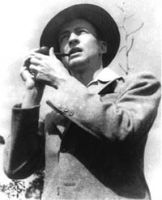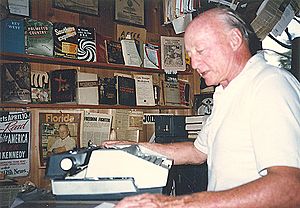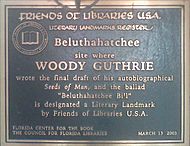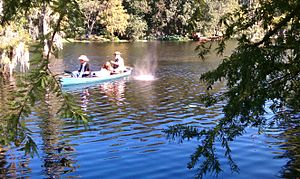Stetson Kennedy facts for kids
Quick facts for kids
Stetson Kennedy
|
|
|---|---|
 |
|
| Born | October 5, 1916 Jacksonville, Florida, U.S. |
| Died | August 27, 2011 (aged 94) Jacksonville, Florida, U.S. |
| Occupation |
|
| Nationality | American |
| Spouse | Sandra Parks (at time of death) |
| Signature | |
 |
|
William Stetson Kennedy (born October 5, 1916 – died August 27, 2011) was an American writer, folklorist (someone who studies traditional stories and customs), and human rights activist. He was one of the first people to collect and study folklore in the early 1900s. He is best known for bravely going undercover to expose the secrets of the Ku Klux Klan in the 1940s. His actions helped authorities and the public learn about the Klan. Because of his work, the state of Georgia took away the Klan's official status in 1947. Kennedy wrote or helped write ten books.
Contents
Early Life and Education
Stetson Kennedy was born on October 5, 1916, in Jacksonville, Florida. His parents were Willye Stetson and George Wallace Kennedy. His family was wealthy and had a long history in the South. Some of his relatives included John B. Stetson, who founded the famous Stetson hat company. An uncle of his was even a high-ranking official in the Ku Klux Klan, called a "Great Titan."
From a young age, Kennedy loved collecting Florida's traditional stories and writing poems about nature. His ideas about race relations in the South were greatly shaped by his family's Black maid, "Flo." Kennedy thought of her as "almost like a mother." He remembered that in the 1920s, local Klan members beat Flo for "sassing whitefolks." This happened after she questioned a bus driver who gave her wrong change. Kennedy later said this incident made him realize that "grownups were lying about a whole lot more than Santa Claus." He was talking about the Klan's false claims of being Christian patriots.
Kennedy went to public schools in Jacksonville. He graduated from Robert E. Lee High School during the Great Depression. In 1935, he started studying at the University of Florida. He left in 1937 without getting a degree. He also studied in New York and Paris, France.
Writing and Activism
In 1936, while at the University of Florida, Kennedy helped collect supplies for the Second Spanish Republic during the Spanish Civil War.
Kennedy is known as one of the first important folklore collectors in the early 20th century. In 1937, he joined the Federal Writers' Project. This was a government program created during the Great Depression to help American writers. As part of this project, the Library of Congress hired people to record American culture. They collected folksongs and oral histories in many languages. For five years, Kennedy traveled Florida, collecting its folklore. He worked with famous writers like Harlem Renaissance writer Zora Neale Hurston and folklorist Alan Lomax. Kennedy helped edit several books for the Federal Writers' Project. These included The WPA Guide to Florida and The Florida Negro.
Kennedy's first book, Palmetto Country (1942), was based on material he collected for the Federal Writers' Project. When it was published, Alan Lomax from the Library of Congress said it was one of the best books ever written about Florida's traditional life.
In 1942, Kennedy started working for the CIO. This was a group of labor unions for factory workers. He wrote articles that spoke out against unfair racist rules. These rules included poll taxes and white primaries. These rules were used in the South to stop minorities, especially African Americans, and poor people from voting.
Fighting the Ku Klux Klan
Kennedy could not join the military in World War II because of a back problem. So, he decided to fight racial injustice at home in the Jim Crow South. He is most famous for going undercover to join the Georgia Ku Klux Klan. He then shared their secrets on the popular children's radio show The Adventures of Superman. This made their rituals seem silly. He also targeted another racist group called the Columbians. Kennedy said, "There were an awful lot of evils abroad in the world at the time... but I couldn't help but feel that racism was perhaps the most evil."
Kennedy worked with the Georgia Bureau of Investigation. He joined several Klan groups using a fake name, John Perkins. He wanted to gather proof that could be used to arrest Klan members. He learned about the Klan's "Invisible Empire" by taking part in their meetings and from a secret helper. As soon as he learned new details, he told police, lawyers, reporters, and human rights groups. In 1947, after a year of undercover work, he testified against the leaders of the Columbians. They were found guilty.
Kennedy said that in 1946, he gave secret information about the Klan to the writers of the Superman radio show. He wanted to take away the Klan's mysterious image. The show then aired 16 episodes where Superman fought the Klan. Kennedy believed that making the Klan's rituals and secret words seem silly hurt their ability to get new members. This led authors Stephen J. Dubner and Steven Levitt to call Kennedy "the greatest single contributor to the weakening of the Ku Klux Klan" in their 2005 book Freakonomics.
Questions About His Work
Some people, like historian Ben Green, later questioned parts of Kennedy's book The Klan Unmasked. Green suggested that some of Kennedy's undercover stories might have been exaggerated. He also claimed Kennedy had a secret helper who did some of the most dangerous work.
However, many scholars and friends defended Kennedy. They said he was open about protecting the identities of his helpers. They also said he combined different stories to make his books more powerful. Peggy Bulger, who wrote her Ph.D. about Kennedy, said he "didn't do it all, but he did plenty." She added that Kennedy's goal was to expose the Klan and use their own traditions against them. Famous oral historian Studs Terkel also supported Kennedy. In 2006, The Florida Times-Union newspaper researched Kennedy's claims. They found that his account of infiltrating the Klan was generally accurate, even if he used dramatic effects in his writing.
David Pilgrim, who runs the Jim Crow Museum of Racist Memorabilia, said that even if Kennedy "embellished his role," infiltrating the Klan was "an act of great courage." He noted that Kennedy's information led to arrests and helped stop terrorist acts.
Later Career
After World War II, Kennedy worked as a journalist for newspapers like PM and New York Post. He also gave information about discrimination to columnists. He wrote several books exposing the Klan and the unfair Jim Crow system. These included Southern Exposure (1946) and Jim Crow Guide to the USA (1959). In the 1950s, some of Kennedy's books were published in France by philosopher Jean-Paul Sartre because they were considered too controversial in the U.S. Kennedy also created the "Frown Power" campaign in the 1940s. It encouraged people to frown when they heard hateful speech.
In 1952, Kennedy ran for governor of Florida. His friend, musician Woody Guthrie, even wrote a campaign song for him. Kennedy said he became "the most hated man in Florida." His home was firebombed, and many of his papers were destroyed. This led him to move to France. There, in 1954, he wrote his famous book I Rode With The Ku Klux Klan (later called The Klan Unmasked).
Kennedy was a founding member of the Florida Folklore Society. He received the Florida Folk Heritage Award in 1998. His work is the subject of Peggy Bulger's Ph.D. paper. He was also featured in Studs Terkel's book Coming of Age.
In 2005, people in Jacksonville, Florida, held a celebration for Kennedy's life. In 2007, St. Johns County declared a "Stetson Kennedy Day." Kennedy's most recent book, Grits and Grunts: Folkloric Key West, was published in 2008. In 2009, he gave his personal library to the Civic Media Center in Gainesville, Florida.
Personal Life
Friends say Kennedy was married seven times, though he only admitted to five. His first marriage was in 1936 to Edith Ogden-Aguilar. He met her in Key West, Florida, while doing research for his writing.
In 1942, he had his only child, a son named Loren Stetson Kennedy.
After leaving Budapest with his Hungarian wife during the Hungarian Revolution of 1956, Kennedy was held in Paris for over a year. This happened because the U.S. government took his passport due to McCarthyism, a time when people were unfairly accused of being disloyal.
In 2006, at 90 years old, Kennedy married Sandra Parks. She was a writer and bookstore owner. They were married until Kennedy passed away in 2011.
Legacy
Beluthahatchee Park
In 2003, Kennedy's home, Beluthahatchee, was named a national literary site by Friends of Libraries USA. To celebrate, Arlo Guthrie held a concert in Jacksonville.
In 2005, Kennedy was given a special right to live on his 4-acre property in Saint Johns County. This property is now called Beluthahatchee Park.
The name "Beluthahatchee" comes from Zora Neale Hurston. She used it to describe a magical "Florida Shangri-la, where all unpleasantness is forgiven and forgotten."
The park has a picnic area, a canoe dock, and places to watch wildlife. There are plans for a "Mother Earth Trail" throughout the property. The park is surrounded by trees and plants, providing a home for many animals and birds.
After Kennedy's death, his home was opened as a museum and archive. It has exhibits about Woody Guthrie, William Bartram, and Kennedy himself. A small log cabin in the park might become a home for an Artist-in-Residence program.
The park is part of a larger 70-acre area that Kennedy bought in 1948. He made sure that parts of the land would always be a wildlife refuge.
Death and Memorials
Stetson Kennedy died on August 27, 2011, in Jacksonville, Florida.
Kennedy wanted a party instead of a funeral after he died. So, a celebration of his life was held on October 1, 2011, at his home, Beluthahatchee Park. This was just four days before his 95th birthday. Hundreds of family, friends, and admirers gathered. The event started with music, including songs written by Woody Guthrie, who wrote many songs at Beluthahatchee. Everyone sang Guthrie's "This Land Is Your Land." After speeches, everyone walked to Lake Beluthahatchee. Kennedy's ashes were then scattered on the lake from a canoe.
Books
- Mister Homer, 1939
- Southern Exposure, University of Alabama Press 2011 reprint, ISBN: 978-0-8173-5672-9
- The Klan Unmasked, University of Alabama Press 2011 reprint: ISBN: 978-0-8173-5674-3
- Jim Crow Guide to the U.S.A., University of Alabama Press 2011 reprint: ISBN: 978-0-8173-5671-2
- Palmetto Country, 1942, University Press of Florida 1989 reprint: ISBN: 0-8130-0959-6, Florida Historical Society Press 2009 reprint with a new publisher's preface, updated Afterward and eighty photographs ISBN: 1-886104-38-7 ; ISBN: 978-1-886104-38-9
- The Jim Crow Guide: The Way It Was Before the Overcoming, 1956 at Paris, 1959, Florida Atlantic University 1990 reprint: ISBN: 0-8130-0987-1
- South Florida Folklife, 1994, (coauthors Peggy A. Bulger and Tina Bucuvalas), University Press of Mississippi, ISBN: 0-87805-659-9
- After Appomattox: How the South Won the War, 1995, University Press of Florida 1996 reprint: ISBN: 0-8130-1388-7
- Grits and Grunts: Folkloric Key West, Pineapple Press, 2008
- The Florida Slave, The Florida Historical Society Press, September 29, 2011, ISBN: 978-1-886104-48-8
Images for kids
See also
 In Spanish: Stetson Kennedy para niños
In Spanish: Stetson Kennedy para niños





